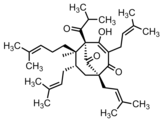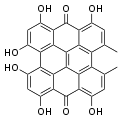Hypericum
| Hypericum | |
|---|---|
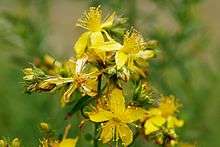 | |
| Hypericum perforatum | |
| Scientific classification | |
| Kingdom: | Plantae |
| Clade: | Angiosperms |
| Clade: | Eudicots |
| Clade: | Rosids |
| Order: | Malpighiales |
| Family: | Hypericaceae |
| Tribe: | Hypericeae |
| Genus: | Hypericum L. |
| Species | |
| Synonyms | |
Hypericum /ˌhaɪˈpiːrɪkəm/ is a genus of flowering plants in the family Hypericaceae (formerly considered a subfamily of Clusiaceae). Hypericum is unusual for a genus of its size because a worldwide taxonomic monograph[1] was produced for it by Norman Robson (working at the Natural History Museum, London). Robson recognizes 36 sections within Hypericum.
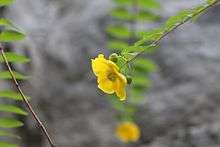
The genus has a nearly worldwide distribution, missing only from tropical lowlands, deserts and polar regions. All members of the genus may be referred to as St. John's wort, and some are known as tutsan. The white or pink flowered marsh St. John's-worts of North American and eastern Asia are now separated into the genus Triadenum.[2]
Description
There are over 490 species in the genus.[1] The name hypericum may derive from the Greek for "above pictures,"[3] for its use over shrines to repel evil spirits, though some have translated it as "above the heath".[3][4] Hypericums range from herbaceous annuals or perennials 5–10 cm tall to shrubs and small trees up to 2 m (6.6 ft) tall. The leaves are opposite, simple oval, 1–8 cm long, either deciduous or evergreen. The flowers vary from pale to dark yellow, and from 0.5–6 cm in diameter, with five (rarely four) petals, most having prominent stamens. The fruit is usually a dry capsule which splits to release the numerous small seeds.
Taxonomy
Hypericum is a large genus, containing 400–500 species.
Sections
Hypericum is broken up into 36 sections, each with its own subsections and species. They include:
- Adenosepalum
- Adenotrias
- Androsaemum
- Arthrophyllum
- Ascyreia
- Brathys
- Bupleuroides
- Campylopus
- Concinna
- Coridium
- Crossophyllum
- Drosocarpium
- Elodeoida
- Graveolentia
- Heterophylla
- Hirtella
- Humifusoideum
- Hypericum
- Inodora
- Monanthama
- Myriandra
- Oligostema
- Olympia
- Origanifolia
- Psorophytum
- Roscyna
- Sampsonia
- Santomasia
- Taeniocarpium
- Takasagoya
- Triadenoides
- Trigynobrathys
- Tripentas
- Umbraculoides
- Webbia
Ecology
Hypericum species are the only known food plants of the caterpillar of the treble-bar, a species of moth. Other Lepidoptera species whose larvae sometimes feed on Hypericum include the common emerald, the engrailed (recorded on imperforate St. John's-wort, H. maculatum), the grey pug and the setaceous Hebrew character.[5] A leaf beetle, Paria sellata, feeds on the foliage of Hypericum adpressum, while ant species Formica montana and F. subsericea decorate their nests with its bright yellow petals.[4] A small, reddish-brown weevil, Anthonomous rutilus breeds in the inflorescences of Hypericum kalmianum and H. swinkianum, the larvae developing within the fruit capsules.[4]
St. John's-worts can occur as nuisance weeds in farmland and gardens. On pastures, some can be more than a nuisance, causing debilitating photosensitivity, and sometimes abortion in livestock. The beetles Chrysolina quadrigemina, Chrysolina hyperici and the St. John's-wort Root Borer (Agrilus hyperici) like to feed on common St. John's-wort (H. perforatum) plants and have been used for biocontrol where the plant has become an invasive weed.[6]
Medical properties
Common St. John's-wort (H. perforatum) has long been used in herbalism. It was known to have medical properties in Classical Antiquity and was a standard component of theriacs, from the Mithridate of Aulus Cornelius Celsus' De Medicina (ca. 30 CE) to the Venice treacle of d'Amsterdammer Apotheek in 1686. Folk usages included oily extract ("St. John's oil") and Hypericum snaps, a small alcoholic drink.[7] Hypericum perforatum is the most potent species and it is today grown commercially for use in herbalism and medicine.[8]
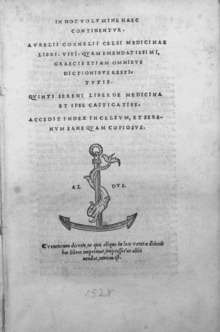
Two main compounds found in Hypericum species have been studied in more detail: hyperforin and hypericin. As psychiatric medication, it is usually taken in pill form, but may also be consumed as a tea. Standardised preparations are commercially available and research has mainly studied alcoholic extracts and isolated compounds. Research has found a noticeable effect in many cases of light and medium clinical depression,[9] but no significant improvement of severe depression and OCD.
The red, oily extract of H. perforatum may help heal wounds.[10][11] Both hypericin and hyperforin are reported to have antibiotic properties.[12] Justifying this view with the then-current doctrine of signatures, herbalist William Coles (1626–1662)[13] wrote in the 17th century that:
"The little holes where of the leaves of Saint Johns wort are full, doe resemble all the pores of the skin and therefore it is profitable for all hurts and wounds that can happen thereunto."
Hypericum perforatum may also be capable of reducing the physical signs of opiate withdrawal.[14]
Hypericum extract, by inducing both the CYP3A4 and the P-glycoprotein (P-gp), can reduce the plasma concentrations of different antineoplastic agents such as imatinib, irinotecan and docetaxel, thus reducing the clinical efficacy of these drugs.[15]
Ornamental plants
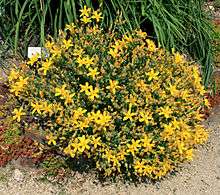
Some species are used as ornamental plants as many have large, showy flowers. Species found in cultivation include:-[16]
Numerous hybrids and cultivars have been developed for use in horticulture, such as H. × moserianum[17] (H. calycinum × H. patulum), H. 'Hidcote'[18] and H. 'Rowallane'.[19] All of the above cultivars have gained the Royal Horticultural Society's Award of Garden Merit.[17][18][19][20]
Most species of Hypericum are prone to thrips, scale, anthracnose, rust, and leaf spots.[21] They are also eaten or infected by aphids, white flies, and spodoptera littoralis.[22]
Fossil record
Fossil seeds from the early Miocene of †Hypericum septestum have been found in the Czech part of the Zittau Basin. [23] Many fossil seeds of †Hypericum holyi have been described from middle Miocene strata of the Fasterholt area near Silkeborg in Central Jutland, Denmark.[24]
See also
References
- 1 2 Hypericum Online
- ↑ Missouri Botanical Garden Retrieved November 23, 2015
- 1 2 Gledhill, David (2008). The Names of Plants, 4th edition. Cambridge University Press. p. 208. ISBN 978-0-521-86645-3.
- 1 2 3 Wilhelm, Gerould; Rericha, Laura (2017). Flora of the Chicago Region: A Floristic and Ecological Synthesis. Indiana Academy of Sciences.
- ↑ "HOSTS-Search Results". HOSTS. Natural History Museum, London. Retrieved 18 February 2016.
- ↑ "Ecology and Management of Common St. Johnswort | NRCS Montana". www.nrcs.usda.gov. Retrieved 2016-02-19.
- ↑ Fine Gardening retrieved November 23, 2015
- ↑ USDA.gov Retrieved November 23, 2015
- ↑ Szegedi, A; Kohnen, R; Dienel, A; Kieser, M (2005). "Acute treatment of moderate to severe depression with hypericum extract WS 5570 (St John's wort): Randomised controlled double blind non-inferiority trial versus paroxetine". BMJ. 330 (7490): 503. doi:10.1136/bmj.38356.655266.82. PMC 552808. PMID 15708844.
- ↑ Samadi, S; Khadivzadeh, T; Emami, A; Moosavi, NS; Tafaghodi, M; Behnam, HR (2010). "The effect of Hypericum perforatum on the wound healing and scar of cesarean". Journal of alternative and complementary medicine. 16 (1): 113–7. doi:10.1089/acm.2009.0317. PMID 20064022.
- ↑ Süntar, Ipek Peşin; Akkol, Esra Küpeli; Yılmazer, Demet; Baykal, Turhan; Kırmızıbekmez, Hasan; Alper, Murat; Yeşilada, Erdem (2010). "Investigations on the in vivo wound healing potential of Hypericum perforatum L". Journal of Ethnopharmacology. 127 (2): 468–77. doi:10.1016/j.jep.2009.10.011. PMID 19833187.
- ↑ Schempp, Christoph M; Pelz, Klaus; Wittmer, Annette; Schöpf, Erwin; Simon, Jan C (1999). "Antibacterial activity of hyperforin from St John's wort, against multiresistant Staphylococcus aureus and gram-positive bacteria". The Lancet. 353 (9170): 2129. doi:10.1016/S0140-6736(99)00214-7. PMID 10382704.
- ↑ Coles, William (1657). Adam in Eden, or, Natures paradise. OCLC 217197164.
- ↑ Subhan, F; Khan, N; Sewell, RD (2009). "Adulterant profile of illicit street heroin and reduction of its precipitated physical dependence withdrawal syndrome by extracts of St John's wort (Hypericum perforatum)". Phytotherapy Research. 23 (4): 564–71. doi:10.1002/ptr.2692. PMID 19067385.
- ↑ Caraci, F; Crupi, R; Drago, F; Spina, E (2011). "Metabolic drug interactions between antidepressants and anticancer drugs: Focus on selective serotonin reuptake inhibitors and hypericum extract". Current Drug Metabolism. 12 (6): 570–7. doi:10.2174/138920011795713706. PMID 21395523.
- ↑ Brickell, Christopher, ed. (2008). The Royal Horticultural Society A-Z Encyclopedia of Garden Plants. United Kingdom: Dorling Kindersley. p. 302. ISBN 9781405332965.
- 1 2 "Hypericum × moserianum". Royal Horticultural Society. Retrieved 19 May 2013.
- 1 2 "Hypericum × hidcoteense 'Hidcote'". Royal Horticultural Society. Retrieved 19 May 2013.
- 1 2 "Hypericum 'Rowallane'". Royal Horticultural Society. Retrieved 19 May 2013.
- ↑ "AGM Plants - Ornamental" (PDF). Royal Horticultural Society. July 2017. p. 52. Retrieved 3 March 2018.
- ↑ Fine Gardening Retrieved November 23, 2015.
- ↑ Dan Ziger Corporation Retrieved November 30, 2015.
- ↑ Acta Palaeobotanica - 43(1): 9-49, January 2003 - Early Miocene carpological material from the Czech part of the Zittau Basin - Vasilis Teodoridis
- ↑ Angiosperm Fruits and Seeds from the Middle Miocene of Jutland (Denmark) by Else Marie Friis, The Royal Danish Academy of Sciences and Letters 24:3, 1985
External links
| Wikimedia Commons has media related to Hypericum. |
| Wikispecies has information related to Hypericum |
- "Hypericum Online".
- University of Illinois Extension. "Selecting Shrubs for Your Home - Kalm St. Johnswort (Hypericum kalmianum)".
